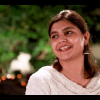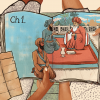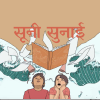Folk-Epics: Ram-Sitamani Varta and Bheelon ka Bharat: Interview with Bhagwandas Patel by Awadhesh Tripathi for Sahapedia
K. Satchidanandan: The Ramayana, I have always felt and said, is not exactly a text but a tradition. A tradition that is various, that is diverse, that has so many layers and that is related to so many different kinds of cultures of the people of different classes—of the tribal people as well as modern people. So we have folk Ramayanas, performed Ramayanas, Ramayanas which have been painted and carved, and of course we have written Ramayanas. So when A.K. Ramanujan speaks about 300 Ramayanas, I am afraid he forgets thousands of other Ramayanas which are also there.
There is a whole tradition of textual Ramayanas. In Malayalam it is said there are at least 23 Ramayanas including Patala Ramayanam where Ravana is helped by another Ravana who lives in the netherworld called Patala Ravana. I mean when Ravana is about to fail, Patala Ravana sends his army to help Ravana in the war against Rama.
And there are so many oral and folk versions of Ramayana like the one that the Bhils (Bheels) have for example, where there is not even a war because they don’t believe in violence, they don’t believe in war. Ravana realises his mistake and returns Sita to Rama and thus arrives at a kind of compromise.
And there is Telugu women’s oral Ramayana where the woman is very central and Sita becomes the main character and her delivery, her pain in the forest, her whole life and attitude to Ram and Lakshman and other people, all these become very important. So even in Valmiki's Ramayana, Sita is of course a central character but here the whole point of view is that of a woman. I mean women are looking at the Ramayana and reading the Ramayana, that is the kind of feeling you get when you go through this Ramayana.
If you go to, say Father Camille Bulcke ‘s (1909–1982) Ramkatha (Ramkatha: Utpatti Aur Vikas) or Paula Richman’s various books on Ramayana, Questioning Ramayanas: A South Asian Tradition (2001) or her last book where she has collected contemporary stories and poems based on the Ramayana which also includes one of my own poems, you will find it is a living tradition. What is important about Ramayana and what we need to remember especially when Ramayana is being treated as a single text that was written by somebody in a single language, I think we are killing a tradition because really speaking, it is a diverse tradition, it is also a living tradition because even today newer and newer versions of Ramayana are emerging. Or people are looking at the Ramayana and retelling the Ramayana in various kinds of forms.
So in Malayalam, Sarah Joseph has written a series of stories on the women characters of Ramayana, like Shambuka’s wife who is not a major character in any of the known Ramayanas and she (Sarah Joseph) has of course written stories on Sita. She has stories on even Mandodari. So you have many kinds of stories there where she looks at the whole of the Ramayana from a woman’s point of view, and to justify women. And is also angry about what Rama did to women including his wife Sita. And you find that in several of the folk Ramayanas. You find they have places associated with Ramayana in all these Ramayanas like in the various tribal versions of Ramayana you find in Wayanad.
And also they bring in their own gods, their beliefs, their goddesses, their own rituals and various geographical sites which are supposed to be associated with the life of Rama or the life of Sita in the forest. And they conceive of Ram and Sita as tribal people, tribal characters like in one of those Adayan Ramayanas where Sita descends the hill with a basket and Rama falls in love with her because she is uniquely beautiful.
And this exactly is the very basis of our democracy because this is not a small question of Ramayanas being various, because we have always tried to have as many texts as possible around not only the Ramayana but also the Mahabharata, we have various kinds of parallel epic traditions in various languages and tribal communities, besides they have also their own epics and many of these are silenced in the mainstream discourse. And that silencing, I believe, is extremely dangerous to any understanding of our culture because our culture can hardly be comprehended unless we understand the entire diversity, the various ways in which texts have been written, performed and stories have been told and retold and retold in so many ways.
So if you look at even contemporary Malayalam literature, I spoke about Sarah Joseph’s stories, you will find C.N. Sreekantan Nair writing in a very different way, his three plays based on Ramayana like Lankalakshmi and Saketham and Kanchana Sita. So there again you find a very new interpretation, unimportant characters become important—Urmila becomes very important for example. Urmila is a minor character in many of the textual Ramayanas but she becomes a very powerful character who questions what Rama did to Sita. And that way if you look at even contemporary interpretations of Ramayana, I myself have a poem called Janki Poru ('Janaki, come'), where Ravana gains salvation, most of the Ramayanas also admit that he is a great hero and a devotee of Shiva and he goes to heaven. And in this poem I imagine that from heaven he is inviting Sita, please come and join me because I am a great singer and one of the greatest lovers in the world, and why do you still want to live with this man who has abandoned you in the forest, who has killed so many innocent people in Sri Lanka, not only people but also trees and animals, and his messenger burned the whole of Lanka and destroyed nature there, so why do you want to live with him. It questions Rama’s basic ethics.
So here I am not doing something new, in fact because there have been many Ramayanas where Ravana is presented as a major character. In all Ramlilas actually Ravana is the major centre of attraction. I have seen many Ramlilas, mainly in Delhi but which also come from neighbouring states, and I find that the best actor is invited to play Ravana and not Rama because Rama is seen as a rather insipid and colourless kind of character while Ravana is a very powerful character because he is chivalrous, he is a great lover, he is a vainik, a great singer and so in many ways he is a much more attractive and spectacular personality than Rama himself. And if you read Kamba’s Ramayana, again you will find Ravana is treated like a hero, he is given all the respect of a real protagonist. I mean, he is by no means less than Rama in his chivalry, in his attitude to life, in his power to love, in his devotion to God etc. Everywhere you find Ravana is shown to be sometimes even superior to and is much more active than Rama.
And even in the Adhyatma Ramayana in Malayalam you find that Rama ultimately pays a great tribute to Ravana. After he kills him, Rama pays tribute to Ravana saying he was an ideal human being but for this single flaw that he had. He was a great human being, a great fighter and a great singer. So he had all the great human qualities that we look for in a human being.
So we have a great tradition of Ramayanas, various Ramayanas, many of which are folk Ramayanas. Reviving folk Ramayanas, I believe, is extremely important for various reasons. One, these Ramayanas are being forgotten and the people who know these stories are perhaps fast disappearing and second, there are various versions, many of which are completely obscure and have not yet been researched upon. And third, in strengthening our democracy, the understanding of the diversity of our literary tradition in general and epic tradition in particular plays a very, very important role. So when democracy itself is being challenged, the democracy of literature is also being challenged, it is extremely important that we recover many of these lost traditions, or traditions which are getting lost, and because it is through folk Ramayanas that we get a complete perception of how people perceived Ramayana.
Of course, we have written Ramayanas, some of them have been written by people like Valmiki and hence they are told from a people’s point of view. But to know deeper, to understand the psyche of the people and the way they look at epics and epic characters and the way they depict these characters and to understand their worldview, it would be wonderful actually to go to these different folk Ramayanas—of the Gonds, of the Bhils, of the Agariyas. I mean, if you look at the various tribes of India, most of the tribes in India have their own versions of Ramayana and going to these folk and tribal versions of Ramayana is a major democratic act in a time like ours, when these people themselves are being marginalised and their stories are also being marginalised. Now we are living in a time when a single version of Ramayana, most often it happens to be Tulsi’s Ramcharitmanas, is being imposed upon all of us and it is said that there can only be a single version of Ramayana. Even though Tulsi himself admits in his own version that there have been so many Ramayanas, but those who swear by Tulsidas would not admit that there are so many other Ramayanas. So there is this kind of superstitious belief in a single, monolithic version of Ramayana which is extremely dangerous to our culture and a threat to the great diversity.
I am not exactly privileging oral tradition over the written tradition. I am only saying that there are written Ramayanas, there are oral Ramayanas, there are performed Ramayanas, there are painted and sculpted Ramayanas and when we speak about Ramayana, we need to take into account all that and not confine ourself to any particular version, whether it is a written version or another kind of version. And the oral Ramayanas as I said are particularly important to a democratic understanding of the Ramayana tradition and the way in which a story adapts itself to various kinds of lifestyles and various landscapes and various places and cultures.
If you just study the Ramayana tradition in India or in south Asia in general, you will get an idea about our culture. So it is an eye through which you can look into the entire range of our culture, the evolution of our civilisation, the various kinds of world views of our people, the richness of our languages. So I think it is extremely important to study a text like Ramayana and not to leave it to the interpretation of a few people who believe that the Ramayana is a single, monolithic text.
Wayanad itself is a very interesting part of Kerala and indeed India, but even that is not a monolith. Often, we create monoliths out of places, like when we speak about India's 'northeast' and now of course it is being questioned that there is nothing like the 'northeast'. There are only these various traditions and the various tribes, cultures and languages of the north-east. Okay, geographically you can say it is the north east of India but you cannot turn it into a monolithic kind of idea of one part of India, because there are various kinds of people living there. They have languages like Ao, Angami and Naga, quite a number of languages and traditions.
And similarly, Wayanad is also generally looked upon as a tribal area. And it is right, I mean geographically speaking, or speaking bureaucratically, there is a district called Wayanad. But then when you go to Wayanad and you go through the various versions of the Ramayana in Wayanad, you find that each tribe has its own story and not only that, within each tribe, each story has its own variations. And then when one man tells a story, it becomes different from the story told by another man or another woman.
And also depending on their language and their culture and their own gods and goddesses and the landscape of the place where they live, these versions assume different forms. The main thing is that they have created Ramayanas where first of all, the major characters belong to their tribes and certainly their entire cosmology, that is, their understanding of the creation of the world, their understanding of various gods and goddesses and their understanding of the relationship between nature and man, all these come into play in each of these Ramayana versions.
So even when you speak of Wayanadan Ramayana, I would rather say Wayanadan Ramayanas because there are various Ramayana versions in Wayanad itself, because each tribe has a different kind of take on the Ramayana. And I think what Azeez has done—the collection of tribal narratives—for example is extremely important as a contribution to the understanding of the Ramayana tradition especially from the point of view of the marginalised. As I said, various tribes have their own Ramayanas and to look at these versions would be important and necessary to challenge the hegemonic idea of Ramayana that is being propagated today.
We need to emphasise our diversity, our cultural diversity, our civilisational diversity, our linguistic diversity, our racial and religious diversity. This is extremely important. And even my own understanding of Indian, I have been a rather close student of Indian literature, I have now begun to use only literature-s, I no more use the singular ‘literature’ in Indian context. And so it is necessary to respect this diversity and not reduce it to a single version because there is no single Indian literature. There is no single Ramayana or single Mahabharata. We have versions and each version is as authentic as another version. You cannot say that this is the authentic version. If you look at various Ramayanas you easily know, they are not mere copies of, say, the Valmiki Ramayana. Ezhuthachan’s Ramayana itself is not based on Valmiki Ramayana, more on the Adhyatma Ramayana even though he has taken some things from Valmiki Ramayana. So even in written versions you find a lot of variety.
And if you look at the various Ramayanas, Krittibas’ Ramayana (Krittibas Ojha's Krittibasi Ramayana) in Bengal for example, or Kamba’s Ramayana in Tamil Nadu, you find that these are all not different versions of a single Ramayana but these are all different Ramayanas. You have to look at that. Because that 'single version' idea comes from the ancient idea that there is one Brahma, and all creation is the phenomenal aspect of a single Brahma. But that is not how culture thrives and survives. I mean these are all creative works. All our Ramayanas are in fact creative works. I mean, they say Vallattol Narayana Menon has done a beautiful translation of Valmiki Ramayana. Well, that is a translation. But the other Ramayanas we have in Kerala or in other parts of India are not in any way translations because there are various changes we see there. The maximum you can say about all these Ramayanas is that there is a character called Rama, there is a character called Ravana, there is a Lakshmana, there is a Sita. Except for this, you find very little similarity among the various Ramayanas, because as I said, as we very well know, there are Ramayanas where there is no war, like the Bhil Ramayana or there are Ramayanas where it is Lakshman who kills Ravana, because Rama is a sanyasi and he cannot use violence, so Lakshman kills Ravana in the Jain Ramayana: that is called Paumacharia.
And similarly in the Buddhist version, Dasharatha becomes very important. And also, there are many versions of the Jaina Ramayana itself. And in another Jaina Ramayana version you find that Ram and Ravana are the incarnation of Vasudeva and Prati-Vasudeva because they have this concept of Vasudeva appearing as the protagonist, the hero of every age, and then a Prati-Vasudeva, an anti- or counter-Vasudeva appearing as a villain. And in Buddha’s own case, it is Buddha and Devadutta. So like that, here, Ravana becomes the Prati-Vasudeva and Rama becomes the Vasudeva. And the whole thing is told in the Jaina tradition, with the Jaina gods and Jaina beliefs and Jaina ethics, all these entering the discourse. And similarly, in Dasaratha Jataka which is the Buddhist Ramayana, again Dasaratha becomes very important and Buddhist principles play a major role in that version of the Ramayana, and Ayodhya becomes a kind of kingdom of absolute peace and non-violence established by Rama.
Of course, one could go on. If you know Paula Richman or Father Camille Bulcke or various other books on the Ramayana or the research done by someone like Sankalia (Hasmukh Dhirajlal Sankalia), you will know that there are various versions. Like the Chandrabati Ramayana for example, where it is completely the women’s point of view from where Rama’s ethics are questioned. And there are multiple references to other Ramayanas in Ramayana texts themselves, as in the Malayalam Adhyatma Ramayana (which is also taken from the original Adhyatma Ramayana) when Rama refuses to take Sita to the forest, she asks, ‘In every other Ramayana, Sita has accompanied Rama, so why not here?’ Today you would call it a kind of meta-literature because there is a kind of reference to other Ramayanas by Sita herself which is an absolutely fascinating kind of situation. And you find this reference to other Ramayanas in many places. I remember Ananthamurthy once saying in Kumara Vyasa’s Bharata he gives this as the reason why he decided to write the Mahabharata. He says that there have been so many Ramayanas already, there is a whole burden of so many Ramayanas, so I am writing this Mahabharata.
So there are references in modern writers as well as ancient writers to other Ramayanas. So all of them have acknowledged the existence of other Ramayanas which is also extremely important when we fight this idea of a single Ramayana or a single text. And so I think our people’s imagination has worked wonderfully and the various Ramayanas embody the power of the imagination of our people. And if you respect the power of people’s imagination, this is the primary thing in democracy, because it is not about head count and it is not about elections, it is about respecting the imagination of the people, allowing them the freedom to imagine the nation in their own way and to relate to it in their own way and allowing them to relate also to literature, to epics, to tradition in their own different ways. If that is the case, definitely the recognition of the diversity of the Ramayana tradition becomes extremely important and only by recognising them and bringing even the buried Ramayanas up and by doing more research on forgotten Ramayanas or Ramayanas which have been completely marginalised because they exist in some language which only a few people speak etc., only by doing that can we really enrich this Ramayana tradition and also that way battle the kind of hegemonic version of Ramayana which is being imposed upon us.
So I think doing research in Ramayana is an extremely positive step in an age like ours. If you do it not to authenticate one particular version but to say how beautiful and how various all these diverse Ramayanas are. And that is why speaking of various Wayanadan Ramayanas or speaking about the Mappila Ramayana, all this become important because they also often represent our syncretic tradition, because the Mappila Ramayana was not propagated by a Muslim but by a Hindu singer and anybody who knows Bali or Indonesia and various versions in Java and other places, they know that there are various Muslim versions of Ramayana. I have myself witnessed them. I have witnessed one of the Ramayana presentations and I have seen that even in their contemporary poetry, Indonesian poetry for example, Rama and Sita etc. keep on appearing. I mean these are written by Muslims apparently but then Rama and Sita are part of their tradition. So not only that it is diverse, no religion can claim Ramayana to be its epic or its Purana or its holy book or anything like that because Ramayana belongs as much to Muslims and other people as to the so-called Hindus. And the tribal people were, you will remember, never Hindus in the modern sense of the term. They are being now converted actually into Hinduism and so in order to claim/reclaim Ramayana for the common people, for the various religions and races and languages of India, for the diverse cultures of India becomes a very important democratic act because Rama has suddenly become a kind of major symbol of everything about the nation. He is a symbol of nationalism, he is a symbol of violence against others, as a symbol of othering. So all that Rama was not. All that, for example, Kabir’s Ram never was. That is what these people (the right-wing) are now trying to turn him into. They are turning him into a very negative icon, a representative of violence, of exclusion and creating a Ramayana which is entirely monolithic. So I think we need to speak about the diversity and to reclaim the Ramayana tradition for our people, for our culture, for our democracy.
Ramayana, as Paula Richman has always pointed out, is a south Asian tradition. It is not even, you cannot say that it is purely an Indian tradition because in all these countries there are places which are associated with the Ramayana. Of course, in India we know in every place there are such places. I have seen Sita’s kitchen in at least five places in India. And there are so many places where the battle is supposed to have taken place or Sita was abandoned in the forest. And similarly, you will find places associated with Ramayana in these countries and also they have their own very different versions of Ramayana. Like in Ramakien for example, in Philippines, in Java and Sumatra, in Indonesia, Malaysia you will find that all over south Asia there are various versions where the importance of Ram and Ravana change and there the story itself is retold in so many different versions. I won’t go into the various kinds of narratives, but there again you find that many of these Ramayanas are different from the various Ramayanas which are in existence in India because they come from different cultures and civilisations and they belong to their own tradition.
So first of all, India alone cannot claim the Ramayana tradition. It belongs to the whole of south Asia. And secondly, the Hindus as a religious group cannot claim Ramayana because there are many Muslim countries, or countries where Muslims are in a majority which consider Ramayana to be part of their great literary tradition, and again because there are tribal people who were never Hindus, who also have their own versions of Ramayana. And so to say this again and again has become extremely culturally important in a time like this.











